John Deere 2550 E-Cut™ Hybrid Diesel Triplex Mower
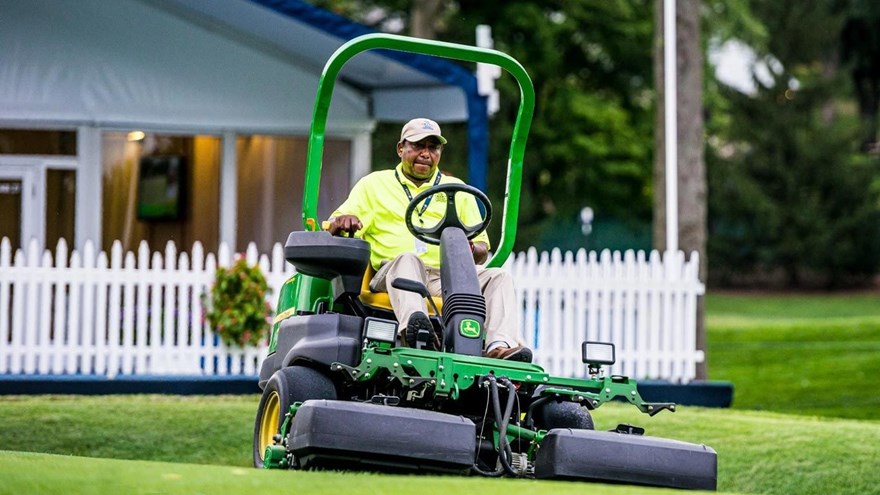
2550 E-Cut™ Hybrid Diesel
Triplex Mower
- A proven design that drives the cutting unit with electric reel motors
- 102 potential leak points eliminated in the reel circuit
- Reduced sound levels and fuel consumption @ 2250 RPM
- Greatly reduce triplex ring with exclusive offset cutting units
-
Get a Quote
Get A Quote
Fields with asterisks* are required. Please email our helpful staff with any questions or comments using the contact form.
-
Payment Calculator
Loan Calculator
Use the Loan Calculator to help you determine the financing and payment options that are best for you.
**The accuracy of this calculator and its applicability to your circumstances is not guaranteed. You should obtain personal advice from qualified professionals. This information is provided for illustrative purposes only and does not constitute an application. This notice does not guarantee loan approval, nor is it an offer or commitment to make a loan to you on the above terms.
- View Product Brochure
-
Share
Print
Features
Electric reel drive system eliminates 102 hydraulic leak points, minimizing leak opportunities
Ninety percent of all hydraulic leaks occur in the reel hydraulic circuit, mainly due to the necessity of having flexible hoses extending from the front of the machine for the front reels. These hoses see a lot of flexing during the mowing day as cutting units are raised and lowered. Cutting units also steer and float to follow undulations, increasing fatigue for the reel motor hoses.
The 2550 E-Cut™ Hybrid Triplex Mower has eliminated 102 potential leak points by removing all hydraulics from the cutting unit drive circuit.
This has eliminated the following hydraulic components:
-
Reel drive section of hydraulic triple pump
-
Hydraulic reel motors
-
Backlapping valve
-
Hydraulic oil cooler
-
Flexible hoses
-
Fittings
-
Hard lines
Fewer hydraulic components leads to fewer leaks, increasing confidence that the finely manicured turf will not be damaged by hot hydraulic oil spilled onto a playing surface before an important tournament.
Reduced sound levels and reduced fuel consumption at 2250 rpm; throttle notch serves as a guide
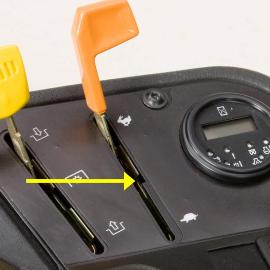 Throttle notch
Throttle notch
The 2550 E-Cut™ Hybrid Triplex Mower is unique because electrical power is used to minimize hydraulic leak opportunities in the reel circuit, but an engine is utilized to ensure optimal performance throughout the day. This presents an opportunity to further enhance machine performance through reduced sound levels and improved fuel savings by running the machine at less-than-full throttle. Scalping and verticutting operations should always be done with the engine at its fullest throttle level.
The 2550 E-Cut Hybrid Triplex Mower can be effectively run in mow at an engine rpm reduced to 2250 rpm. At this operating rpm, the operator may experience up to a 6-dB(A) reduction in sound on diesel machines and 4 dB(A) on gas machines, compared to operating at full throttle. Keep in mind that decibel-amp is measured on a logarithmic curve, so even a 1-dB(A) sound reduction is substantial.
Actual measured sound levels are as follows:
| Full engine rpm | 2550 Diesel |
| With Greens Tender™ conditioner and power brush | 84 dB(A) |
| Without Greens Tender conditioner and power brush | 84 dB(A) |
| 2250 engine rpm | 2550 Diesel |
| With Greens Tender conditioner and power brush | 78 dB(A) |
| Without Greens Tender conditioner and power brush | 78 dB(A) |
In addition to the reduced sound levels, you may also experience fuel savings as well. Current studies have shown that, depending on conditions and usage, fuel savings can be as high as 30 percent when running the machine at 2250 rpm as opposed to running at full throttle.
To help operators gauge the 2250-rpm level, a throttle notch has been incorporated into the slot for the throttle lever. To approximate 2250 rpm, the bottom edge of the throttle lever should line up with the notch in the throttle lever slot. This will not equate to exactly 2250 rpm, but will get operators close to this level, allowing them to effectively reduce sound levels and decrease fuel consumption during operation.
Brushless electric reel motors for compact design and optimal efficiency
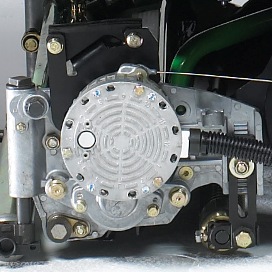 Reel motors
Reel motors
The electric reel motors on the 2550 E-Cut™ Hybrid Triplex Mowers are brushless, allowing them to be compact in size, roughly equal to that of today's hydraulic reel motors. The brushless motors are very efficient, leading to years of optimal performance with very minimal maintenance, and sealed for protection from the elements.
The motors are bidirectional and variable speed, meaning they can spin forward or reverse and at a range of rotational speeds. The motors spin forward for mowing and scalping operations and backward for verticutting and backlapping operations.
A simple switch on the reel switch box controls the direction of rotation, and a rotary dial on the switch box controls the speed of rotation.
A poly chain belt connects the motor shaft to the reel and rotates the reel when the cutting units are engaged. The internal components of the motor are epoxy sealed for long life, durability, and protection from the elements.
Cutting units are easily removed from the cutting unit motors by loosening the two bolts securing the motor to the cutting unit, turning the motor approximately one-quarter turn, and pulling the motor from the cutting unit. This can be done in a matter of seconds. A tether prevents damage to the wiring harness when the motor is removed.
48-V alternator powers reel drive motors, requiring no additional batteries on unit
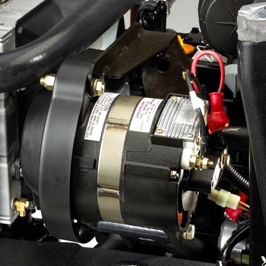 48-V alternator
48-V alternator
The reel circuit is powered by a 48-V, 100-amp alternator belt-driven by the engine. The alternator supplies constant power to the reel circuit and only generates the 48 V when the mow system is engaged.
Due to this design, no additional batteries are required to drive the reel motors on the 2550 E-Cut™ Hybrid Triplex Mower. With traditional electrical mowing systems, the frequency of clip would change as the batteries drained while mowing.
A battery pack begins to lose its power immediately when used, but not on the 2550 E-Cut Hybrid. Since the 2550 E-Cut Hybrid still uses an engine to drive an alternator, the frequency of clip on the first green and the last green are exactly the same, yielding unparalleled quality of cut from start to finish.
Plus, you don't have to plug the machine in to charge the batteries once your day of mowing is done. The only limitation on run time with the 2550 E-Cut Hybrid is making sure the operator starts the day with a full fuel tank, just like any other gas- or diesel-powered machine on the market today.
The alternator only supplies power to the reel circuit. The remainder of the circuits are powered by the same 12-V battery used on the 2550 PrecisionCut™ Triplex Mower.
Quiet and powerful diesel engine
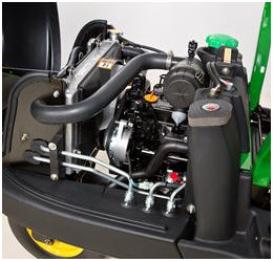 Diesel engine
Diesel engine
The 2550 PrecisionCut™ and 2550 E-Cut™ Hybrid Riding Greens Mowers use a 14.6 kW (19.6 hp)* gross (per SAE J1995 at 3000 rpm) liquid-cooled diesel engine for smooth, efficient, and quiet operation.
With the 3-cylinder diesel engine and a large 29.9-L (7.9-U.S. gal.) fuel tank, the 2550 models give the operator power and fuel for a productive day of mowing.
*Engine horsepower and torque information are provided by the engine manufacturer to be used for comparison purposes only. Actual operating horsepower and torque will be less. Refer to the engine manufacturer’s website for additional information.
55.9-cm (22-in.) cutting unit rear-attaching-point yoke kit for fairways, surrounds, and tees
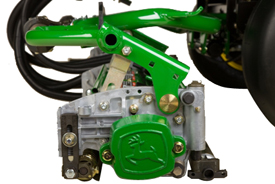 Rear attaching yoke
Rear attaching yoke
Low weight and compaction of a riding greens mower with the mowing system of a fairway mower equals great quality of cut in fairways and surrounds.
Many golf courses want to mow their fairways and other areas with riding greens mowers as a way to decrease compaction of the turf. However, the front-attaching-point yoke system used for greens is not the ideal solution for other areas due to the mowing speed, and the terrain is not as smooth as a green.
The 55.9-cm (22-in.) cutting unit rear-attaching-point yoke kit attaches to the rear cutting unit to help keep the rear roller on the ground consistently in undulating terrain. This also substantially improves cut quality by maintaining a consistent height of cut in virtually any condition. Rather than pushing the cutting unit through the turf, the yoke system pulls the cutting unit through the turf keeping the back end of the cutting unit engaged with the turf.
14-blade reel lowers frequency of clip
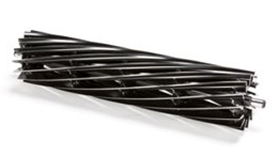 14-blade reel
14-blade reel

Using the 14-blade reel on greens mowers will lower the frequency of clip and also provide a clean, smooth cut. It can increase the playability of the putting surface and greens speed.
Frequency of clip (FOC) is defined as the distance traveled between consecutive cuts. In other words, it is how far the machine moves from the time one blade passes across the bedknife until the next blade passes. The lower the frequency of clip, the less distance that is traveled until the next blade passes.
There is a point of diminishing returns when it comes to frequency of clip. The less distance the mower travels between consecutive cuts, the more times the same grass blade is going to be impacted by the reel. Too low a frequency of clip can cause bruising of the turf - especially in the overlap from pass to pass.
Frequency of clip is often used as a measurement of cut quality, however there are other key factors that attribute to gaining good quality of cut. The factors that lead to good cut quality are:
- Geometry of the cutting unit
- Sharpness of reels and bedknife
- Proper cutting-unit setup (parallel and bedknife-to-reel clearance)
- Height of cut (HOC) (effective versus bench HOC)
- Bedknife selection
- Roller selection for the turf conditions
- Turf conditions
The geometry of John Deere cutting units makes the optimum range for frequency of clip between 0.160 in. (4.064 mm) and 0.190 in. (4.824 mm) for walk greens mowers. This is where the technology of the PrecisionCut™ walk greens mowers excels and provides a superior cut and after-cut appearance.
Machines |
14-blade reel part number |
Minimum FOC |
Minimum FOC with AMT2865* |
180SL PrecisionCut Walk Greens Mower |
TCA23624 |
3.58 mm (0.141 in.) |
3.12 mm (0.123 in.) |
220SL PrecisionCut Walk Greens Mower |
TCA23623 |
3.58 mm (0.141 in.) |
3.12 mm (0.123 in.) |
*Frequency speed-up kit
Optional direct mount front grass-catcher system easy to install and remove
The optional direct mount front grass catchers provide the choice of systems to meet the needs on your golf course.
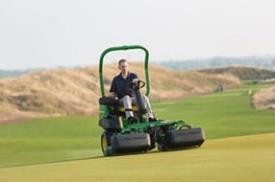 Front grass catcher
Front grass catcher
The grass catcher is mounted directly to the front cutting unit using a similar design as the SL Walk Greens Mowers.
This provides quick access for the removal and installation of the grass catcher as well as superior ground following and collection due to position of the catcher to the cutting unit.
It is recommended that catchers be emptied after each green during normal and heavy growth times to reduce weight on the cutting unit.
The direct mount grass catchers will fit model year 2009 to current 2500B and 2500E E-Cut Riding Greens Mowers with Quick-Adjust 5 (QA5) cutting units, as well as 2400 PrecisionCut™, 2550 PrecisionCut, and 2550 E-Cut™ Hybrid Triplex Mowers.
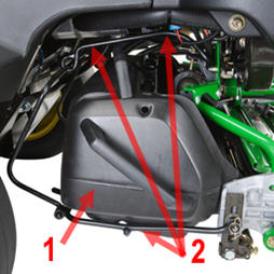 Rear grass catcher (1) and bail system (2)
Rear grass catcher (1) and bail system (2)
The rear grass-catcher mounting system simplifies removal and installation of the rear grass catcher and reduces effort.
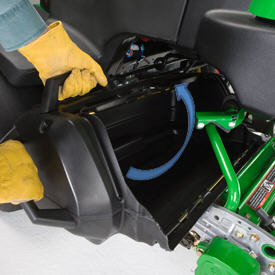 Rear grass catcher
Rear grass catcher
The grass catcher can be easily removed without spilling the clippings by rotating the grass catcher back toward the front of the machine until the front grass catcher lip is above the cutting unit side plate. Then, simply pull it out to the side. This can be accomplished with the cutting unit in the raised or lowered position.
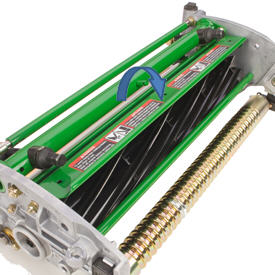 Adjustable top shield
Adjustable top shield
Adjustable cutting-unit top shields also ensure that grass is thrown into the back of the catcher, even as the reel diameter decreases due to wear. The catchers are shaped and vented to allow the air from the reel to escape while retaining the clippings.
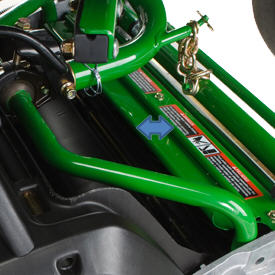 Top-shield extension for dry conditions
Top-shield extension for dry conditions
Extensions for the cutting-unit top shields are for use in dry conditions to maximize the flow of dry clippings into the grass catcher. If mowing predominantly in wet-turf conditions, remove the cutting unit shield extensions to reduce buildup and accumulation of clippings on the front of the grass catcher.
Optional weight transfer grass-catcher system transfers clipping weight to frame, rather than to cutting unit
Most golf courses want to mow the greens and collect the grass for a premium cut and even and smooth appearance. The most challenging concern with catching grass with a greens mower is that as the grass catcher fills with material, its weight is transferred to the cutting unit. This problem is multiplied with a riding greens mower because there are three cutting units and grass catchers collecting different amounts of grass, meaning different weights are applied to the three cutting units.
If the weight cannot be removed from the grass catchers, the different weights can cause different heights of cut with each cutting unit, leaving poor playing conditions and after-cut appearance. This is especially noticeable through undulations of a green and on the clean-up pass. The grass catchers on the riding greens mowers have been designed for optimum catching efficiency while maintaining a consistent, effective height of cut.
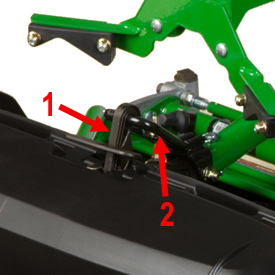 Grass catcher clip (1) and lift arm bracket (2)
Grass catcher clip (1) and lift arm bracket (2)
The exclusive John Deere grass catcher transfers approximately two-thirds of the weight to the vehicle's lift arm. This helps maintain a more-consistent cutting height to ensure a uniform cut across all three cutting units.
The front grass catchers can be removed and installed with one hand because of an innovative clip system. The clip secures the catcher to an adjustable bracket on the lift arm, transferring weight from the catcher to the lift arm as clippings accumulate in the catcher.
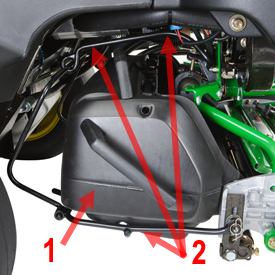 Rear grass catcher (1) and bail system (2)
Rear grass catcher (1) and bail system (2)
The rear grass catcher mounting system simplifies removal and installation of the rear grass catcher and reduces effort.
The retaining bail system for the rear grass catcher also uses the exclusive John Deere design to transfer the weight of the grass catcher to the lift arm.
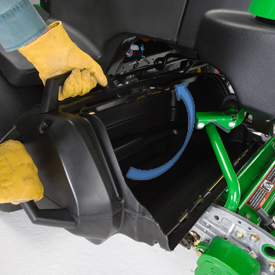 Rear grass catcher
Rear grass catcher
The grass catcher can be easily removed, without spilling the clippings, by rotating the grass catcher back toward the front of the machine until the front grass catcher lip is above the cutting unit side plate. Then, simply pull it out to the side. This can be accomplished with the cutting unit in the raised or lowered position.
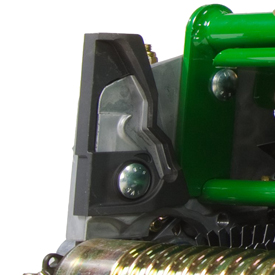 Grass catcher channel
Grass catcher channel
A channel in the cutting unit side frames guides the grass catcher onto the cutting unit. The channel in the castings ensures the grass catcher lip maintains its relationship with the cutting unit when following undulations, providing for better grass catching efficiency.
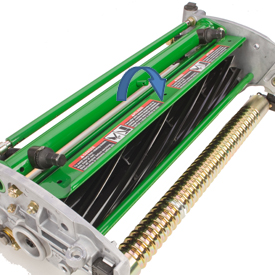 Adjustable top shield
Adjustable top shield
Adjustable cutting-unit top shields also ensure that grass is thrown into the back of the catcher, even as the reel diameter decreases due to wear. The catchers are shaped and vented to allow the air from the reel to escape while retaining the clippings.
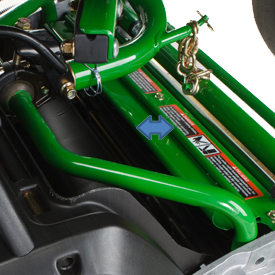 Top-shield extension for dry conditions
Top-shield extension for dry conditions
Extensions for the cutting-unit top shields are for use in dry conditions to maximize the flow of dry clippings into the grass catcher. If mowing predominantly in wet-turf conditions, remove the cutting unit shield extensions to reduce buildup and accumulation of clippings on the front of the grass catcher.
Larger, 63.5-mm (2.5-in.) front grooved disc roller compatible with fairway tender conditioner (FTC) and Greens Tender™ conditioner attachment for 55.9-cm (22-in.) Quick-Adjust 5 (QA5) reel cutting units
 Grooved disc roller
Grooved disc roller
The grooved disc roller can be used with 55.9-cm (22-in.) QA5 cutting units, in combination with the Greens Tender Conditioner and FTC, to provide additional roller options for fairway, tees, and approach areas.
The increased diameter improves the durability over smaller rollers, and it features hardened discs for improved wear which retains spring tension for reduced maintenance, making it an ideal roller for fairway, tee, and approach mowing.
Key specs
| Number of cylinders | 3-cylinder |
|---|---|
| Displacement | 993 cc 60.6 cu in. |
| Mowing speed | Adjustable mow stop: 0-7.1 km/h 0-4.4 mph |
| Reel drive | Electric |
| Reel power source | Alternator, 48 V 100 amp |
| Mower size | Quick Adjust QA5 floating: 55.9 cm 22 in. |
| Clip frequency | For 14 blade: 0.53 mm/km/h 0.034 in./mph with 11-blade reel: 0.67 mm/km/h 0.043 in./mph with 7-blade reel: 1.06 mm/km/h 0.067 in./mph |
| Reel diameter | 12.7 cm 5 in. |
| Height-of-cut | 2-36 mm 0.078-1.42 in. with front roller: 51 mm 2 in. or 4-46 mm 0.16-1.80 in. with front roller: 76.2 mm 3 in. |
| Mowing position width | 157.5 cm 62 in. |
Engine
| Type | Liquid-cooled diesel |
|---|---|
| Engine horsepower | Per SAE J1995 @ 3000 rpm: 14.6 kW 19.6 hp *Engine hp is provided by engine mfr. for comparison purposes only. Actual operating hp will be less. |
| Air cleaner | Semi-cyclone, dry-type, dual-stage |
| Cooling | Liquid |
| Oil filter | Full-flow filter |
| Engine oil capacity | 2.2 L 2.3 U.S. qt |
| Pressurized lubrication system | Standard |
| Number of cylinders | 3-cylinder |
| Displacement | 993 cc 60.6 cu in. |
Electrical System
| Charging system | Flywheel, alternator |
|---|---|
| Alternator capacity | 20 amp |
| Ignition | |
| Battery type | BCI group 40 maintenance-free - 12 V |
| Starter | Electric (solenoid shift) |
Vehicle Specifications
| Wheels and tires | Front 18x10.5-10, 2-ply smooth; 20x10-10, 2-ply or 4-ply smooth; or 20x10-10, 2-ply turf tread Rear 18x10.5-10, 2-ply smooth; 20x10-10, 2-ply or 4-ply smooth; or 20x10-10, 2-ply turf tread |
|---|---|
| Brakes | Type Dual: 15.2 cm 6 in. Single pedal, 2-wheel disc brakes |
| Mowing speed | Adjustable mow stop: 0-7.1 km/h 0-4.4 mph |
| Transport speed | 0-12.9 km/h 0-8.0 mph |
| Reverse speed | 0-4.8 km/h 0-3 mph |
| Ground clearance with catcher | 10.2 cm 4 in. |
| Fuel tank capacity | 29.5 L 7.8 U.S. gal. |
| Muffler | Horizontal discharge below frame |
| Hydrostatic capacity (total) | 28.8 L 7.6 U.S. gal. |
| Hydrostatic reservoir capacity (only) | 20.4 L 5.4 U.S. gal. |
| Ground drive, reel drive | Traction drive Hydrostatic, 2-pedal control Reel drive Electric Reel power source Alternator, 48 V 100 amp Reel control Voltage regulated |
| Hydraulic filtration | 10 micron |
| Filtration |
Mower
| Number | 3 - Offset design |
|---|---|
| Size | Quick Adjust QA5 floating: 55.9 cm 22 in. |
| Backlapping | Standard on machine, variable adjustment capability |
| Clip frequency | For 14 blade: 0.53 mm/km/h 0.034 in./mph with 11-blade reel: 0.67 mm/km/h 0.043 in./mph with 7-blade reel: 1.06 mm/km/h 0.067 in./mph |
| Front rollers | Optional smooth, machine grooved, or spiral: 5.1 cm 2 in. |
| Reel diameter | 12.7 cm 5 in. |
| Bedknife adjustment | Bedknife-to-reel |
| Height-of-cut | 2-36 mm 0.078-1.42 in. with front roller: 51 mm 2 in. or 4-46 mm 0.16-1.80 in. with front roller: 76.2 mm 3 in. |
| Number of blades | Choice of 7, 11, or 14 |
| Mower lift | (1) Hydraulic cylinder for front two units, (1) hydraulic cylinder for center unit |
Operator Controls
| Steering | Hydraulic, adjustable column |
|---|---|
| Reel lift | Right hand (optional foot controls) |
| Throttle | Right hand |
| Park brake | Right foot |
| Reel drive | Right hand |
| Glow plug switch and indicator light | Automatic, on instrument panel |
| Hydrostatic speed | Forward Right foot Reverse Right foot |
| Ignition | Key start and shutoff |
Instrumentation
| Engine oil pressure | LED Warning light |
|---|---|
| Alternator | LED Warning Light |
| Hydraulic oil temperature | LED Warning Light |
| Engine coolant temperature | LED Warning Light |
| Hourmeter | Digital |
Electrical and Safety System
| Diagnostics | On-board diagnostics with White Box Controller and (SOS) Sit on Seat Diagnostics |
|---|---|
| Safety interlocks | Operator presence switch (in seat), backlap switch, mow/transport switch, park brake set switch |
Certification
| Number | ANSI B71.4-2004 |
|---|---|
| ROPS | 2-Post SAE J21294 Roll Over Protection Structure with Seat Belts meets pending ISO 21299 standards |
| Engine | Engine meets EPA Tier 2, Interim Tier 4 |
Weights and Dimensions
| Wheelbase | 129.5 cm 51 in. |
|---|---|
| Tread width | 101.5 cm 40 in. |
| Mowing position width | 157.5 cm 62 in. |
| Turning radius uncut circle | 45.7 cm 18 in. |
| Weight (full fluids, no operator or fuel) | 637.3 kg 1405 lb |
Sound Levels at Operator Ear
| Full engine rpm | 84 dBA |
|---|---|
| Reduced engine rpm (2250) | 78 dBA |
Additional information
| Date collected | 31-Oct-2019 |
|---|
Would you like more information?
Free Parts Delivery to
Drop Boxes!
OUR DEPARTMENTS
DEALER TRANSFER
OUR INVENTORY
OUR PRODUCTS
© Copyright 2017 - 2025 Ballweg Implement All Rights Reserved. Site by EquipmentLocator.com
